
Tuesday, April 3, 2012
Best Android Phones

Motorola Droid Bionic

Pros
- Dual-core and Verizon 4G is a speedy combination
- Assortment of entertainment and business features
- HD 1080p video capture
- Lots of compatible accessories
Cons
- Pricey
- Call quality is uneven
- Display disappoints
Bottom Line
The
long-awaited Droid Bionic is blazing fast and has a slew of great
entertainment and business features, but the high price might make it a
hard sell.
It feels as if we’ve waited an eternity (well, about nine months) for the Motorola Droid Bionic ($300 with a two-year contract as of September 7, 2011) to come to Verizon,
but the dual-core 4G phone has finally arrived. While you might cringe
at the steep price, the dual-core TI OMAP processor paired with
Verizon’s superspeedy LTE network makes for one fast phone. But the
Bionic falls short in its display and call quality, making that high
price tag seem a bit unreasonable.
(Editor’s note: We will be lab-testing the Droid Bionic over
the next few days, and we will update this review--and possibly the
score--depending on the results.)
The 4.3-inch qHD (Quarter High Definition) display isn’t as sharp as we expect a 960-by-540-pixel screen to be. The images I loaded from my Facebook profile looked a little grainy, with a slight bluish tint. I could also see a grid of dots in the image--even without zooming in. Unfortunately, this isn’t the first time we’ve taken issue with a Motorola phone’s display. The Photon also had a slight bluish tint, and the Droid 3’s qHD display suffered from the dots issue. I was impressed, however, with how sharp the text looked in the browser and in Gmail.
Unlike other Motorola phones, though, the Bionic is not tied to the MotoBlur cloud service. Instead, you get an app called ZumoCast, which lets you access remote files on your PC without having to upload or sync your files. You can access everything from PowerPoint files to your iTunes playlists on your Bionic. Even though the Droid Bionic has plenty of storage (1GB of RAM, 16GB of on-board memory, and a preinstalled 16GB MicroSD card), I find it nice to be able to access videos, documents, photos, and other media files without having to download them to the device or upload them to a cloud service.
We also tested the phone using Qualcomm's new benchmarking app, Vellamo, just to see how a TI processor would fare against its competitors. The Droid Bionic earned a score of 715, which places it below the HTC Sensation and EVO 3D (both of which are powered by Qualcomm chipsets) but above the Motorola Atrix 4G (which uses an Nvidia Tegra 2 chip). We take these scores with a grain of salt since Qualcomm manufactures the app, but the data is interesting to compare.
Call quality over Verizon’s network was uneven. My friends’ voices sounded hollow and blown out, as if they were talking too close to the speaker. Sometimes I found it hard to understand them, and I had to adjust the volume on almost every call. My friends, on the other hand, were more positive. I made a few of my calls next to a loud generator, but my friends reported that they could not hear it in the background.
We’re still conducting our battery-life tests on the Droid Bionic, so we’ll update with a full report once we’re finished. Battery life with regard to Verizon’s 4G phones has been a hot issue, so we plan on investigating the Droid Bionic’s battery as thoroughly as possible. According to Motorola, the Droid Bionic offers 650 minutes of talk time and 200 hours of standby time, and takes 3.5 hours to obtain a full battery charge. It has the largest battery of all Verizon LTE devices, at 1735 mAh.
 Like
most of the latest and greatest smartphones, the Droid Bionic has an
8-megapixel camera. It can shoot up to 1080p HD video, too; it's the
first Verizon LTE phone to be able to do so. When I met with Motorola, I
asked the product managers why the Droid Bionic took so long to come to
market. Their response? Among other features, 1080p was added to the
phone after Motorola's initial CES announcement.
Like
most of the latest and greatest smartphones, the Droid Bionic has an
8-megapixel camera. It can shoot up to 1080p HD video, too; it's the
first Verizon LTE phone to be able to do so. When I met with Motorola, I
asked the product managers why the Droid Bionic took so long to come to
market. Their response? Among other features, 1080p was added to the
phone after Motorola's initial CES announcement.
 We've
never been blown away by the image quality on Motorola cameras--the
white balance tends to be off, giving photos and video a bluish tint.
The Photon’s camera was slightly better than those of other Motorola
phones, such as the Droid 3 and the Triumph,
so I had rather high expectations for the Bionic’s camera. Thankfully,
it met my expectations: Although the Droid Bionic’s camera isn’t the
best I’ve seen (that honor goes to the T-Mobile MyTouch 4G Slide), I was
pleased with the sharpness, color accuracy, and brightness of my indoor
and outdoor photos.
We've
never been blown away by the image quality on Motorola cameras--the
white balance tends to be off, giving photos and video a bluish tint.
The Photon’s camera was slightly better than those of other Motorola
phones, such as the Droid 3 and the Triumph,
so I had rather high expectations for the Bionic’s camera. Thankfully,
it met my expectations: Although the Droid Bionic’s camera isn’t the
best I’ve seen (that honor goes to the T-Mobile MyTouch 4G Slide), I was
pleased with the sharpness, color accuracy, and brightness of my indoor
and outdoor photos.
Video capture was quite good. The Droid Bionic’s camera handled action without any pixelation or artifacting. Color looked good, and the microphone did a good job of handling audio.
The enhanced gallery displays photos from your own library, in online libraries (Facebook, Flickr, Photobucket, and finally Picasa), or in your friends' libraries on assorted social networks and on DLNA servers.
High-Quality Design, Disappointing Display
When you pick up the Bionic, you’ll immediately notice its high-quality feel and sturdy construction. The dark gray, soft, rubberized battery cover is nice in the hand, and the Corning Gorilla Glass face gives it a sophisticated feel. The Bionic’s design isn’t as fun as that of the Photon 4G (Sprint), which has a futuristic, angular look. It's somewhat blocky, and it feels a little large (though admittedly my hands are a bit small). Measuring 5.00 by 2.63 by 0.43 inches, the Droid Bionic is the slimmest LTE phone on Verizon. It weighs 5.6 ounces, slightly lighter than the Photon.The 4.3-inch qHD (Quarter High Definition) display isn’t as sharp as we expect a 960-by-540-pixel screen to be. The images I loaded from my Facebook profile looked a little grainy, with a slight bluish tint. I could also see a grid of dots in the image--even without zooming in. Unfortunately, this isn’t the first time we’ve taken issue with a Motorola phone’s display. The Photon also had a slight bluish tint, and the Droid 3’s qHD display suffered from the dots issue. I was impressed, however, with how sharp the text looked in the browser and in Gmail.
Software: Built for Business and Entertainment
Like the Photon 4G and the other hot phones of the fall, the Droid Bionic runs the latest version of Android, 2.3.4 (Gingerbread). It also runs Motorola’s custom-built MotoBlur widgets, including the social networking widget, which aggregates all of your account profiles into a single view on your home screen. The widgets are resizable (à la Android Honeycomb), and you can scroll through them; in the calendar widget, for example, you can scroll through a whole day’s worth of events rather than viewing one event at a time.Unlike other Motorola phones, though, the Bionic is not tied to the MotoBlur cloud service. Instead, you get an app called ZumoCast, which lets you access remote files on your PC without having to upload or sync your files. You can access everything from PowerPoint files to your iTunes playlists on your Bionic. Even though the Droid Bionic has plenty of storage (1GB of RAM, 16GB of on-board memory, and a preinstalled 16GB MicroSD card), I find it nice to be able to access videos, documents, photos, and other media files without having to download them to the device or upload them to a cloud service.
Performance
The Droid Bionic takes about 43 seconds to turn on fully. Much of that time is consumed by a Verizon Droid logo animation, which plays while the phone is loading. The graphics look neat, but the fact that a phone this powerful takes so long to boot is kind of surprising. Once you’re up and running, operating the phone is smooth sailing throughout. In my tests, flipping through the Bionic’s menus was very fast with no lag or stuttering. The browser loaded Web pages quickly, over Wi-Fi and 4G. Over Verizon’s LTE network, PCWorld.com loaded in 18 seconds, and the image-heavy TheBoldItalic.com loaded in an impressive 8.3 seconds. Over Wi-Fi, PCWorld.com loaded in a speedy 3.3 seconds.We also tested the phone using Qualcomm's new benchmarking app, Vellamo, just to see how a TI processor would fare against its competitors. The Droid Bionic earned a score of 715, which places it below the HTC Sensation and EVO 3D (both of which are powered by Qualcomm chipsets) but above the Motorola Atrix 4G (which uses an Nvidia Tegra 2 chip). We take these scores with a grain of salt since Qualcomm manufactures the app, but the data is interesting to compare.
Call quality over Verizon’s network was uneven. My friends’ voices sounded hollow and blown out, as if they were talking too close to the speaker. Sometimes I found it hard to understand them, and I had to adjust the volume on almost every call. My friends, on the other hand, were more positive. I made a few of my calls next to a loud generator, but my friends reported that they could not hear it in the background.
We’re still conducting our battery-life tests on the Droid Bionic, so we’ll update with a full report once we’re finished. Battery life with regard to Verizon’s 4G phones has been a hot issue, so we plan on investigating the Droid Bionic’s battery as thoroughly as possible. According to Motorola, the Droid Bionic offers 650 minutes of talk time and 200 hours of standby time, and takes 3.5 hours to obtain a full battery charge. It has the largest battery of all Verizon LTE devices, at 1735 mAh.
Good Camera, Great Gallery
 Like
most of the latest and greatest smartphones, the Droid Bionic has an
8-megapixel camera. It can shoot up to 1080p HD video, too; it's the
first Verizon LTE phone to be able to do so. When I met with Motorola, I
asked the product managers why the Droid Bionic took so long to come to
market. Their response? Among other features, 1080p was added to the
phone after Motorola's initial CES announcement.
Like
most of the latest and greatest smartphones, the Droid Bionic has an
8-megapixel camera. It can shoot up to 1080p HD video, too; it's the
first Verizon LTE phone to be able to do so. When I met with Motorola, I
asked the product managers why the Droid Bionic took so long to come to
market. Their response? Among other features, 1080p was added to the
phone after Motorola's initial CES announcement. We've
never been blown away by the image quality on Motorola cameras--the
white balance tends to be off, giving photos and video a bluish tint.
The Photon’s camera was slightly better than those of other Motorola
phones, such as the Droid 3 and the Triumph,
so I had rather high expectations for the Bionic’s camera. Thankfully,
it met my expectations: Although the Droid Bionic’s camera isn’t the
best I’ve seen (that honor goes to the T-Mobile MyTouch 4G Slide), I was
pleased with the sharpness, color accuracy, and brightness of my indoor
and outdoor photos.
We've
never been blown away by the image quality on Motorola cameras--the
white balance tends to be off, giving photos and video a bluish tint.
The Photon’s camera was slightly better than those of other Motorola
phones, such as the Droid 3 and the Triumph,
so I had rather high expectations for the Bionic’s camera. Thankfully,
it met my expectations: Although the Droid Bionic’s camera isn’t the
best I’ve seen (that honor goes to the T-Mobile MyTouch 4G Slide), I was
pleased with the sharpness, color accuracy, and brightness of my indoor
and outdoor photos.Video capture was quite good. The Droid Bionic’s camera handled action without any pixelation or artifacting. Color looked good, and the microphone did a good job of handling audio.
The enhanced gallery displays photos from your own library, in online libraries (Facebook, Flickr, Photobucket, and finally Picasa), or in your friends' libraries on assorted social networks and on DLNA servers.
Accessories Galore
Like the Photon and the Atrix, the Droid Bionic can hook up to a special dock that lets you access your phone in “webtop” mode. When you connect to the webtop dock, you can access the full Firefox browser as well as a slew of specially made productivity apps. Certain apps (such as Angry Birds) can run at full screen on a larger display. The Droid Bionic has all sorts of accessories available for it, including the Motorola Lapdock ($300, like the one that was advertised with the Atrix), a standard dock ($40), a vehicle navigation dock ($40), and an HD station ($100). We’ll be taking a closer look at the accessories in the next few days, so stay tuned.Bottom Line
Although we’re still wrapping up our lab tests of the Droid Bionic, it is safe to say that this is one of Verizon’s strongest phones available right now. The build quality is excellent, the software is clean and intuitive, and the addition of ZumoCast is terrific. The display, however, is a big disappointment. The overall speed of the Droid Bionic is almost enough to make up for that shortcoming, but the high price makes the phone a tough sell. On the plus side, if you’re upgrading from a basic handset or feature phone to the Bionic, you’ll get a $100 gift card toward your Verizon bill or any accessories. That’s a good incentive, but it seems like a big leap to go from a phone that can only make calls to this dual-core, 4G beast. It might be more fair to extend such an offer to 3G Droid owners or, at the very least, to owners of the original Droid.Motorola DROID RAZR MAXX

Pros
- Dual-core processor keeps phone running smoothly
- Excellent battery life over LTE
Cons
- Doesn't run latest version of Android
- Camera is just average
Bottom Line
The Droid Razr Maxx packs in a dual-core processor, large battery and LTE in a very thin frame.
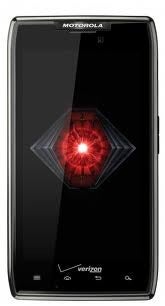 If the Motorola Droid Razr Maxx
($300 with a two year contract from Verizon; price as of 1/27/12) looks
familiar, that’s because it is virtually identical to the Droid Razr. The big difference between the Razr Maxx and the Razr is battery life: Motorola claims that the Razr Maxx gets 21 hours
of talk time on a charge. One of the weaknesses I found with the
original Razr is that battery life drained rapidly over Verizon’s LTE, a
common problem among the carrier’s fleet of 4G phones. Are Motorola’s
claims true? Does the Droid Maxx’s battery hold up over 4G? While we
didn’t finish talk time testing in time for this review (we will update
once it is complete), the Razr Maxx’s handled video streaming and gaming
over LTE with very little strain on the battery.
If the Motorola Droid Razr Maxx
($300 with a two year contract from Verizon; price as of 1/27/12) looks
familiar, that’s because it is virtually identical to the Droid Razr. The big difference between the Razr Maxx and the Razr is battery life: Motorola claims that the Razr Maxx gets 21 hours
of talk time on a charge. One of the weaknesses I found with the
original Razr is that battery life drained rapidly over Verizon’s LTE, a
common problem among the carrier’s fleet of 4G phones. Are Motorola’s
claims true? Does the Droid Maxx’s battery hold up over 4G? While we
didn’t finish talk time testing in time for this review (we will update
once it is complete), the Razr Maxx’s handled video streaming and gaming
over LTE with very little strain on the battery.(Editor’s Note: The Software, Display and some of the Design sections of this review were taken from the original Droid Razr review as the phones are almost identical).
Design
The Droid Razr Maxx is pretty much identical to the Droid Razr in design however it is slightly thicker and heavier. But really, the difference isn’t too noticeable. The Razr Maxx weighs 5.11 ounces and measures 0.35 inches thick while the Razr weighs 4.48 ounces and measures 0.28-inches thick. The Razr Maxx is still incredibly thin and is on par in slimness with the Samsung Galaxy Nexus, also on Verizon.
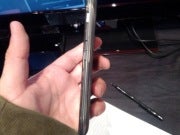 The
soft-touch back is made out of Kevlar, a material found in high-end
speedboats, bulletproof jackets, and bicycle tires. According to
Motorola, Kevlar is five times stronger than steel. Using Kevlar on a
phone seems a bit, well, weird, but I was surprised with how delicate it
felt and how attractive it looked.
The
soft-touch back is made out of Kevlar, a material found in high-end
speedboats, bulletproof jackets, and bicycle tires. According to
Motorola, Kevlar is five times stronger than steel. Using Kevlar on a
phone seems a bit, well, weird, but I was surprised with how delicate it
felt and how attractive it looked.The solid feel comes from the Droid Razr’s stainless steel core. It also has splashguard technology, which will protect it if you happen to get caught in the rain or spill something on your phone.
Super AMOLED Display
We’ve knocked other Motorola smartphones, such as the Photon (Sprint) and the Droid Bionic (Verizon) in the past for its PenTile displays. The Droid Razr, however, ships with a 4.3-inch qHD (Quarter High Definition), 960-by-540-pixel Super AMOLED display. According to Motorola, the Super AMOLED technology should solve some of the battery issues associated with LTE phones. This technology has lower current consumption, which helps to conserve battery life.
The Droid Razr’s display has excellent viewing angles and visibility outdoors, two trademarks of Super AMOLED technology. Blacks are very deep and whites are bright, but colors look a bit oversaturated (another trademark of Super AMOLED display technology.
I did a side-by-side comparison of the Droid Razr against the iPhone 4S. The iPhone 4S has a slightly higher resolution at 960-by-640, with a pixel density of 330 pixels per inch (I could not find any pixel density information for the Razr). While I appreciated the extra screen real estate on the Razr, the iPhone 4S’s 3.5-inch display looked sharper, with better color accuracy.
Performance
As I mentioned previously, we haven’t yet lab tested Motorola’s claims that the Droid Maxx can withstand 21 hours of talk time. I did some informal tests over 4G, however and was quite impressed with the Droid Maxx’s battery life. After playing Minecraft for 20 minutes, battery life decreased only 5%. I also ran the State of the Union address on YouTube (which runs for 1:05:13) in HQ (high quality) and battery life only dropped by 20%. I played the game Madden NFL 12 (which comes preloaded on the Razr Maxx) for 10 minutes and the battery didn’t drain at all.
Not only did battery life hold strong in these games, but performance was excellent. The graphics look terrific on the Razr Maxx’s display and gameplay was smooth without any glitches. Overall, this is an excellent gaming phone. The Razr’s 1.2GHz dual-core TI OMAP 4430 processor scored a notable 1040 on the Vellamo mobile benchmarking app for Android (made by Qualcomm).
Call quality was very good over Verizon’s network in San Francisco. I got coverage almost everywhere I went and never experienced any dropped calls. My friends and family sounded loud and clear, with no static or distortion.
Software
The Droid Razr runs Android 2.3.5. It isn’t a pure version of Android, but it isn’t Motorola’s busy (and often annoying) custom overlay/service, MotoBlur. It does retain some of the MotoBlur widgets. The interface is almost identical to that of the Droid Bionic, but with a few tweaks. The widgets are resizable, and you can scroll through them; in the calendar widget, for example, you can scroll through a whole day’s worth of events rather than viewing one event at a time.
Like the Bionic, you get the ZumoCast app/service, though here it has been renamed MotoCast. MotoCast lets you access remote files on your PC without having to upload or sync your files. You can access everything from PowerPoint files to your iTunes playlists on your Razr. Even though the Razr has plenty of capacity (1GB of RAM, 16GB of on-board storage, and a preinstalled 16GB MicroSD card), I find it nice to be able to access videos, documents, photos, and other media files without having to download them to the device or upload them to a cloud service.
Motorola is determined to solve the LTE battery life situation. Smart Actions, a new app, lets you set reminders to notify you when you should recharge your phone (for example, when you go to bed). If you forget to plug your phone in, you can set a Smart Action called “Nighttime Battery Saver,” which adjusts your phone’s network and screen settings to make your battery last longer the next day.
Smart Actions aren’t just about saving battery life. You can create different profiles (Work, Home, Workout, and so on) and set rules for each scenario. If you don’t want your phone to ring out loud when you’re at work, you can set a rule called Quiet Location so your phone automatically goes into silent mode during work hours. Overall, Smart Actions is an easy-to-use, clever app. Although you’ll have to spend a bit of time setting up the rules for each profile, once that's done, Smart Actions will make all the adjustments for you.
Camera
The 8-megapixel camera on the Razr Maxx is identical to the original Droid Razr. And unfortunately, image quality isn’t the best. All of my photos seemed to have a bit of a dark cast to them--even photos taken in natural light. Details weren't as sharp as I would have liked, either. The flash tends to blow out colors and details quite a bit, so use it only when absolutely needed.
Accessories and Webtop
Like the Droid Bionic and the Photon, the Droid Razr is compatible with a slew of accessories, such as the LapDock 500 Pro, a laptop-like portal for the phone. The LapDock 500 Pro has a 14-inch display and a front-facing camera. When you connect to the Webtop dock, you can access the full Firefox browser as well as lots of specially made productivity apps. Other accessories include an HD Station, a vehicle navigation dock, and a standard dock.
Bottom Line
The Droid Razr Maxx greatly improves upon what was perhaps the biggest weakness of the Droid Razr: battery life. If you plan on watching a lot of video or doing some heavy duty gaming on your phone, the Razr Maxx is a good match for you. If you’re looking to save money, however, you might opt for the original Razr; it costs $100 less than the Razr Maxx.
Samsung Galaxy S II (T-Mobile)

Pros
- Massive and colorful display
- Extremely powerful mobile processor
- NFC chip
Cons
- No MicroSD card included
- Small bezel around the screen
Bottom Line
Like the rest of the Galaxy S II series, the Galaxy S II on T-Mobile is one of the best phones currently available, hands down.
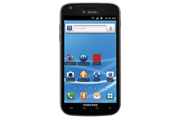 Considering
the massive screen, the crazy-powerful processor, and the NFC and 4G
support, it’s hard not to fall in love with the Samsung Galaxy S II on
T-Mobile. Available for $220 with a new two-year contract (as of October
10, 2011), the Galaxy S II is a great phone. It has just a few minor
flaws that keep it from being truly amazing.
Considering
the massive screen, the crazy-powerful processor, and the NFC and 4G
support, it’s hard not to fall in love with the Samsung Galaxy S II on
T-Mobile. Available for $220 with a new two-year contract (as of October
10, 2011), the Galaxy S II is a great phone. It has just a few minor
flaws that keep it from being truly amazing.A Tablet-Size Phone
The Galaxy S II boasts the same gigantic, 4.52-inch (480-by-800-pixel resolution) screen we saw on the Epic Touch 4G for Sprint--and that impressive screen is definitely the phone's biggest draw. Colors on the Super AMOLED Plus display appear bright and vibrant, if a little oversaturated. The phone is extremely lightweight, thanks largely in part to its plastic casing. I was never really a fan of the plasticky body of the original Galaxy S, but the Galaxy S II feels solid enough that I can overlook it here.At 5.11 by 2.71 by 0.37 inches, the T-Mobile Galaxy S II is slightly taller and thicker than the version made for AT&T. When comparing the two phones side by side, I found that I preferred the AT&T Galaxy S II over the T-Mobile one simply because it was much more comfortable to hold. Although larger screens are great for activities such as watching movies or browsing the Web, I thought that the screen size of the T-Mobile Galaxy S II seemed like a bit of overkill on Samsung’s part.
The biggest problem I have with the T-Mobile Galaxy S II is how narrow the bezel is at the sides of the screen. When I navigated the large screen, the bottom part of my hand would constantly hit one of the capacitive buttons under the screen, or brush against the bottom quarter of the touchscreen. Whenever I went to check a notification or enter a URL in the browser, I also ended up opening a menu or launching the dialer. In one instance, I was in the middle of composing a text message, and I wound up closing out of it several times before I could send it.
Specs and Performance
With a 1.5GHz dual-core Qualcomm Snapdragon processor, the T-Mobile Galaxy S II is the most powerful one of the bunch. Everything from basic phone functions to intense 3D games run as smooth as silk. The only time the phone ever slowed down or got stuck was when I tried unlocking it: The lock screen hung for about 3 seconds before responding. To be fair, at the time I was downloading and installing 15 apps at once, so that could explain the minor hiccup I experienced. The phone comes with a Task Manager; since the handset has 1GB of RAM, however, you shouldn’t ever need to use it.To--ahem--better test how well the Galaxy S II handled games, I downloaded and played Minecraft: Pocket Edition on the device. The game ran well and looked great on that massive display--the Galaxy S II makes for an above-average mobile gaming device. After a good hour of play, I noticed the phone getting really warm, but it wasn't hot enough to be uncomfortable to hold. I also noticed that my hour of gameplay had little effect on the battery--I probably could have squeezed another 2 to 3 hours of Minecraft in if I were so inclined. After about 4 hours of heavy use over 4G, I managed to drain the phone’s battery completely. Samsung has rated the phone as lasting 167 hours on standby, but we’ll have to wait for the PCWorld Labs to test the phone officially to see if that claim holds up.
Call quality on the T-Mobile Galaxy S II was nice and even in San Francisco, but the people I called said that I sounded slightly distorted. The occasional hiss and warping cropped up on my end, but it was hardly noticeable. Overall I can say that making calls using the Galaxy S II was an excellent experience.
Using the Speed Test app as an informal network test, I managed to get 3 megabits per second down and 0.44 mbps up in San Francisco. We don’t have the best T-Mobile 4G coverage here, but those speeds are typical of what we have seen with past 4G T-Mobile devices.
Software and Extras
The Samsung Galaxy S II runs Android 2.3.5 (Gingerbread) and has a few preloaded apps. Netflix comes preinstalled, and runs extremely well over 4G. I could have done without the Blio and Zinio apps, but I can see their usefulness for people who like to read while on the go.Being a Samsung phone, the Galaxy S II also sports the latest version of TouchWiz. Personally, I prefer vanilla Android or the HTC Sense overlay, but TouchWiz has a few things that I really enjoy. Aside from the bright and colorful icon set, this iteration of TouchWiz employs motion controls for basic actions. To zoom in on a Web page, for instance, you simply place both thumbs on the screen and tilt the phone forward or backward. I found this motion far more intuitive than pinch-to-zoom, and far more accurate.
In addition, I was pleasantly surprised to find out that the T-Mobile Galaxy S II comes with a Near Field Communication chip. With such a chip, the Galaxy S II can read NFC-compatible tags. We haven’t seen many phones that support NFC, and it’s a neat technology that I wish more phone manufacturers would include in their devices.
Multimedia
Considering the phone's giant screen, you’ll likely want to watch movies on this handset. Although I’m not normally a fan of using a phone as a media player, I can see the appeal of doing so with a display of this size. If you are adamantly against watching videos on your phone, you can easily share them with your DLNA-enabled devices using AllShare. The
phone has 12GB of internal storage, but unfortunately it doesn’t come
with a MicroSD card. The Galaxy S II is a stellar music player, though,
and could easily replace your stand-alone MP3 player. Should you decide
to make the Galaxy S II your primary audio device, the phone comes with a
pair of (mediocre) headphones that you can use.
The
phone has 12GB of internal storage, but unfortunately it doesn’t come
with a MicroSD card. The Galaxy S II is a stellar music player, though,
and could easily replace your stand-alone MP3 player. Should you decide
to make the Galaxy S II your primary audio device, the phone comes with a
pair of (mediocre) headphones that you can use.Photos that I took with the phone's 8-megapixel camera turned out sharp and clear. Colors seemed a little off, but still looked good overall. The 2-megapixel front-facing camera also did a good job of capturing still images, though it works better for video chat. The Galaxy S II records video at 1080p, and holds its own as a video camera; it picks up voices nicely, but the footage suffers from a jelly effect when you move the phone around.
Bottom Line
The Samsung Galaxy S II is the best phone you can buy right now on T-Mobile. This is a top-of-the-line phone, and it's perfect for people who love larger screens. Though some people may find the handset a little too big, the inclusion of 4G and NFC means that this device won't feel dated down the line. If you crave true power from your smartphone, and if you want the best that your carrier has to offer, the Galaxy S II is the phone to get.T-Mobile MyTouch 4G Slide

Pros
- Outstanding camera
- Latest software and chipset technology
- Wide range of shooting modes and editing tools
Cons
- Keyboard is difficult to type on
- No HDMI port
Bottom Line
The MyTouch 4G Slide has one of the best cameras we've ever tested--and the rest of the phone is pretty amazing as well.
Earlier this month, T-Mobile announced the latest addition to its MyTouch family, the myTouch 4G Slide
($200 with a two-year contract, as of July 15, 2011). The specs look
pretty standard for this summer's slew of high-end smartphones: 4G
connectivity, a 3.7-inch Super LCD screen, Android 2.3 and a dual-core
processor. All of this is great and everything, but what really caught
my eye were the camera's specs. In fact, T-Mobile claims that the Slide
has the most advanced camera of any smartphone available. So how does
the Slide hold up as both a phone and a camera? Read on to find out.
Slider DesignAs the name implies, the HTC-built MyTouch 4G Slide has a slide-out full QWERTY keyboard in addition to a 3.7-inch WVGA super LCD touchscreen. For a slider phone, I was surprised with how thin the Slide is at only 0.54 inches thick. For comparison, the keyboard-less myTouch 4G is 0.43 inches thick. It weighs a manageable 6.5 ounces.
The keyboard's keys are nicely spaced and large enough, but unfortunately they are a bit too flat for my liking. I found myself using Swype on the touch keyboard more than the physical keyboard.
Killer Camera
 The
Slide has an 8-megapixel camera and an HD camcorder that can shoot
video in up to 1080p. It also has an array of advanced features. As
phones beat editor, my camera knowledge is pretty basic, so I went to
our cameras beat editor, Tim Moynihan, to decipher some of these specs
and features for me.
The
Slide has an 8-megapixel camera and an HD camcorder that can shoot
video in up to 1080p. It also has an array of advanced features. As
phones beat editor, my camera knowledge is pretty basic, so I went to
our cameras beat editor, Tim Moynihan, to decipher some of these specs
and features for me.The Slide supposedly has zero shutter lag, which sounds good on paper, but it is something we definitely needed to put to the test. According to Tim, the autofocus system has to be pretty fast in order to capture non-blurry images without any delay. Looks like T-Mobile's claims are true; the Slide's camera was perfectly snappy and smoothly handled every subject we threw at it.
The camera has a backside illuminated sensor, which is fairly standard in the most recent crop of point and shoot cameras these days, which works well for low-light situations without need for a flash. The Slide's F2.2 lens is a wider aperture than many recent cameras, which also translates to better low-light shooting without the flash.
 SweepShot exampleThe
SweepShot mode is similar to Sony's Sweep Panorama mode, which is very
cool. You press the shutter and move the camera from right-to-left, and
the camera stitches together a panoramic image instantly. This mode is
incredibly fun to play with and the photos look pretty good (see
example) though sometimes they don't stitch up accurately.
SweepShot exampleThe
SweepShot mode is similar to Sony's Sweep Panorama mode, which is very
cool. You press the shutter and move the camera from right-to-left, and
the camera stitches together a panoramic image instantly. This mode is
incredibly fun to play with and the photos look pretty good (see
example) though sometimes they don't stitch up accurately. HDR exampleThe
ClearShot HDR mode is a lot like the iPhone's HDR feature. It snaps a
group of photos in rapid succession at different exposure levels, then
"stacks" them in the camera to bring out highlights in shadowy areas and
create an HDR shot. In my opinion, HDR can either look really cool or
really bizarre and blurry. It is fun to play around with, though (take a
look at the example).
HDR exampleThe
ClearShot HDR mode is a lot like the iPhone's HDR feature. It snaps a
group of photos in rapid succession at different exposure levels, then
"stacks" them in the camera to bring out highlights in shadowy areas and
create an HDR shot. In my opinion, HDR can either look really cool or
really bizarre and blurry. It is fun to play around with, though (take a
look at the example).BurstShot is a really unique feature for a phone camera. This mode takes pictures in rapid succession as you hold the shutter button down (paparazzi style). BurstShot is useful for snapping photos of quick-moving objects, like kids and pets.
 Macro exampleMacro
mode lets you take close-up shots of objects like the Furby, pictured
here. You can get as close as about three inches to your object before
the camera starts to lose focus. Tim says that this is pretty good, but
there are point-and-shoot cameras that can shoot even closer.
Macro exampleMacro
mode lets you take close-up shots of objects like the Furby, pictured
here. You can get as close as about three inches to your object before
the camera starts to lose focus. Tim says that this is pretty good, but
there are point-and-shoot cameras that can shoot even closer.Image quality is excellent for a phone camera. A lot of camera phones have a difficult time handling colors. Tim said that the Slide is on a par with $200-to-$300 stand-alone point-and-shoot cameras. According to Tim, the camera's interface is the best touch interface he's seen on a camera. It is easy to navigate, responsive, and provides helpful information for shooting in various environments.
Video quality was very good as well. In my casual tests, the Slide handled quick-moving objects without any distortion or pixelation. We'll have full camera and video test results posted next week.
Sense and MyTouch Come Together
The user interface is sort of a mash-up between the latest version of HTC Sense and the custom-built UI we saw on the T-Mobile MyTouch 4G. According to T-Mobile, the MyTouch rocks the same version of Sense (Sense 3.0) as the HTC Sensation (also on HTC). The latest version of Android, Gingerbread, is running underneath Sense.
You get a new customizable lock screen, which works similarly to the newly announced lock screen in iOS 5. You can pick a theme for your lock screen (the phone offers quite a few of them to choose from) and then select four apps that you visit most frequently. When you turn on your phone, you'll see the four apps at the bottom of the screen. To unlock the screen, simply drag the circle into position over an app, at which point you'll jump straight to that app. Thanks to this feature, you don't have to go through multiple menus to reach your e-mail or other frequently accessed items.
The new version of Sense has a spruced-up Walls system, too. Rather than having to flick back and forth between your walls, as you do in the stock Android operating system, you can flick the Slide's screen to make the walls spin. The effect is reminiscent of a rotating carousel. And like the older version of Sense, you can pinch anywhere in your homescreen to see thumbnail-size images of your walls.
The MyTouch 4G Slide comes with a few preloaded apps including T-Mobile Video Chat powered by Qik for the front-facing camera and Group Text by Bobsled, which lets you send and receive text messages with groups of friends.
Performance
Call quality over T-Mobile's network in San Francisco was reliably good and I did not experience any dropped calls. My friends on the other end of the line reported my voice sounded a bit distant, but clear with no distortion.
T-Mobile's HSPA+ network is weak where our office is located so I tested the Slide in a number of different locations around the city.
The Slide's dual-core Qualcomm Snapdragon processor (the same you'll find in the HTC Sensation and the HTC EVO 3D) easily handled all the apps and media-heavy sites we threw at it. We also tested the phone using Qualcomm's new benchmarking app, Vellamo. The Slide scored an 803, placing it right behind the HTC Sensation, also on T-Mobile.
Bottom Line
When I hear about phones with a single headlining feature, like say a really powerful camera, I worry that the rest of the phone isn't up to snuff. This isn't the case with the MyTouch 4G Slide, however. The Super LCD touch display, slim design and software place the Slide at the top of this year's mega-smartphones. Of course, if you're a serious photographer, the camera on the Slide probably won't cut it for you. But if you snap a lot of photos with your phone or don't want to carry both a phone and a standalone camera at all times, the MyTouch 4G Slide can get the job done.
HTC Rezound

Pros
- 720p display
- Incredibly fast dual-core processor
- Beats Audio built-in
Cons
- Preloaded with bloatware
- Terrible battery life
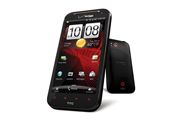 The
HTC Rezound ($300 with a new two-year contract as of January 3, 2012)
is one of the more capable devices released in the past year. With beefy
specs, including a 1.5GHz dual-core Snapdragon processor and Verizon LTE 4G connectivity, the Rezound holds its own against other Verizon smartphones.
The
HTC Rezound ($300 with a new two-year contract as of January 3, 2012)
is one of the more capable devices released in the past year. With beefy
specs, including a 1.5GHz dual-core Snapdragon processor and Verizon LTE 4G connectivity, the Rezound holds its own against other Verizon smartphones.Design
With a 4.3-inch, 1280-by-720-resolution super LCD screen, the Rezound is definitely on the larger side. Although the phone may not fit in everyone’s pocket, the roomy display is great for watching movies and playing games. At 6 ounces, the Rezound can feel a bit hefty, but that weight also makes the phone feel rock solid.Like most other HTC phones, the Rezound has a straightforward design. On the front of the device are the four standard Android navigation buttons (Home, Menu, Back, and Search), as well as a 2-megapixel front-facing camera. The back of the Rezound sports an 8-megapixel camera with dual-LED flash, and it has a soft rubber surface that feels nice in the hand. The volume rocker and power button sit flush with the rest of the phone, giving it a very streamlined look, but also making them somewhat difficult to press. Buttons aside, the Rezound is still very well designed.
Specs and Performance
When it comes to specs, the Rezound is a beast. The dual-core 1.5GHz Snapdragon processor keeps the phone feeling zippy and is great for running graphics-intensive games such as Grand Theft Auto 3 and Dead Space. Unfortunately all that power comes with a price: The Rezound’s battery life is less than optimal. After I spent 3 hours playing games, browsing the Web, and downloading apps over LTE, our fully charged test Rezound had only 30 percent of the battery remaining. The Rezound has several different modes to help regulate power consumption; if you are a heavy apps user, however, you will want to invest in an extended battery pack. We will update this section once we put the Rezound through our official battery tests.The high-resolution display looks great, but it sometimes lagged when I pressed a button or swiped between home screens. This usually occurred after I exited an app, but it didn’t happen enough to be a nuisance.
The Rezound takes advantage of Verizon’s blazing LTE network. Here in San Francisco, I was able to download several hundred megabytes' worth of data in only a few short minutes over a strong connection. Using the FCC-approved Ookla Speed Test app, I clocked download speeds of around 11.55 megabits per second, and upload speeds of about 10.38 mbps. Call quality was even, with no hiss or static. The people I called said that I came through clearly, and that they couldn’t hear any background noises in my call.
Software
The Rezound runs HTC Sense over Android 2.3 (Gingerbread) and comes with a handful of preloaded software. The Amazon Kindle app, Blockbuster Mobile, Polaris Office, and Slacker Radio all come preinstalled, along with the full version of Need for Speed Hot Pursuit and a demo of Let’s Golf 2. While some of these apps may be useful and entertaining, it’s a shame that you have no option to uninstall any of them should you not want them cluttering your phone.The HTC Sense overlay runs well on the Rezound, and brings along a few features that are missing from stock Gingerbread. The lock screen allows you to launch applications quickly without having to unlock your phone first, and the notification bar contains a list of recently opened applications for easier multitasking. The Rezound is slated to receive Android 4.0 (Ice Cream Sandwich) sometime later this year; it will be interesting to see how Sense interacts with the new OS.
Entertainment
If you like to use your smartphone as a media player, you will be interested to learn that the Rezound has built-in Beats Audio for better listening. When you plug in Beats Audio-compatible headphones, the Beats Audio software will enable itself and will supposedly “enhance” the audio.In my tests, I concluded that the Beats Audio software does make music sound better when enabled--but only because normal playback sounds muffled and murky. You’ll want to keep the Beats Audio software enabled whenever you listen to music on the Rezound. If you don’t happen to have Beats-compatible headphones already, try the pair that HTC has graciously included along with the phone. Although they aren't the best headphones ever, they do a better job than most headphones you find prepackaged with phones these days.
The HD episode of Doctor Who that I watched on the Rezound looked excellent, and streaming video over LTE worked flawlessly. As I mentioned earlier, the Rezound’s robust processor makes it awesome for games, and a few hours of playing Dead Space on the Rezound certainly made my daily commute enjoyable.
Camera
 Outdoor test shot using the RezoundThe
8-megapixel camera on the Rezound is decent enough for everyday photos,
but performs poorly in dimly lit environments. In areas with good
lighting, colors can look washed out, and objects can sometimes have a
reddish tint. The front-facing camera offers good image quality, but you
most likely won’t use it for anything besides a few self-portraits.
Outdoor test shot using the RezoundThe
8-megapixel camera on the Rezound is decent enough for everyday photos,
but performs poorly in dimly lit environments. In areas with good
lighting, colors can look washed out, and objects can sometimes have a
reddish tint. The front-facing camera offers good image quality, but you
most likely won’t use it for anything besides a few self-portraits.The Rezound is capable of recording in 1080p, and it did well at picking up audio. It produced a mild jelly-like effect when recording in 1080p, but the result wasn't the worst that I’ve seen. Something that I must commend HTC on is the amount of options available in the camera software: You can fine-tune various aspects for better photos, including sharpness, saturation, and exposure, and the Rezound even features a panorama mode that makes it extremely easy to capture panoramic images.
Bottom Line
The HTC Rezound is one of the best phones available in terms of specs, and it's perfect for media junkies who like to use their smartphone as a multimedia player. The high-resolution display is well suited for movies, and the included Beats Audio headphones are a much-appreciated bonus. The battery life is weak, however, so you will want to buy an extended battery or carry a charger around just in case.Now for the hard part: choosing between the Rezound and the Samsung Galaxy Nexus. Both are excellent devices, but the decision comes down to what you are looking for in a phone. If you want a phone that is always up-to-date with the latest software, go with the Galaxy Nexus. If you value specs more and can wait a few months for Ice Cream Sandwich, the Rezound will suit you just fine.
HTC Evo 3D HTC Evo 3D Review: Dual-Core, 3D Display, 4G Speeds

Pros
- Fast dual-core speeds
- Ultimate entertainment phone
- Gorgeous design
Cons
- 3D cool, but gimmicky
- Call quality uneven
Bottom Line
Uneven call quality doesn't stop the Evo 3D from being the best phone currently available on Sprint.
I'm not sold on 3D for consumer devices,
and I'm certainly skeptical of it on a smartphone-size screen. However,
Sprint and HTC make a great team, so I decided to keep an open mind
about the HTC Evo 3D.
Did the Evo 3D change my opinion of 3D phones? Well, let's just say it
is a very good thing that there's more to this phone than just a 3D
display.Solid, Beautiful Design
 First
and foremost, the Evo 3D is a gorgeous phone. Like the Evo 4G, the Evo
3D is black with blood-red detailing. Keeping it in the family, the Evo View Android tablet,
also announced today, has the same color scheme. The Evo 3D smartphone
feels solid, but not bulky in the least. It has a nice, textured rubber
backing and a slimmer shape that feels good in hand.
First
and foremost, the Evo 3D is a gorgeous phone. Like the Evo 4G, the Evo
3D is black with blood-red detailing. Keeping it in the family, the Evo View Android tablet,
also announced today, has the same color scheme. The Evo 3D smartphone
feels solid, but not bulky in the least. It has a nice, textured rubber
backing and a slimmer shape that feels good in hand.With the battery in place, the HTC Evo 3D weighs 6 ounces. It measures about 5 inches tall, nearly 3 inches wide, and 0.47 inches thick. Its display is a 4.3-inch 3D touchscreen with a sheet of Gorilla Glass for added toughness. Unlike the Evo 4G, the Evo 3D doesn't sport a kickstand--mainly because the twin 3D cameras occupy most of the space on the rear.
3D Display
One of the most important features of the Evo 3D is, of course, its 3D display. The phone uses parallax barriers to display 3D images and video, without the need for clunky 3D glasses (similar to the concept used on the Nintendo 3DS). The Evo 3D's 4.3-inch qHD 960-by-540-pixel screen looks terrific in 2D--and pretty good in 3D, as well. Let me be clear, however: This isn't the kind of 3D you'd see at the movie theater. Images aren't exactly flying in your face. Rather, it looks like you can peer into the phone much like a diorama.You need to maintain an absolute dead-on viewing angle to properly appreciate the third dimension, though. If you're viewing at a slight angle, the image will look like a blurry mess. This can be difficult with a small screen. With an image or a short video clip, it isn't too hard to hold the phone directly in front of your eyes for a few seconds. And don't even think about trying to watch 3D movies outside; it completely fades in bright sunlight. If you don't want to view 3D images and prefer to stick to the standard 2D display, a toggle switch on the side of the device allows you to turn the effect off.
New HTC Sense User Interface
Like the HTC Sensation, the Evo 3D comes with the latest version of the Sense user interface. Sense 3.0 has a brand-new customizable lock screen. You can pick a theme for your lock screen (the phone offers quite a few to choose from) and then select four apps that you visit the most. When you turn on your phone, you'll see those four apps at the bottom of the screen. To unlock your phone, you drag the circle and move it over an app; you then jump straight to that app. That way, you don't have to go through multiple menus to reach your e-mail or any other items you access frequently.The new version of Sense also has a spruced-up Walls system. Rather than having to flick back and forth between your walls, as you do in the stock Android operating system, you can flick the Evo 3D's screen to make the walls spin. The effect is slightly reminiscent of a carousel and makes navigation a little easier.
You'll find a clutch of new widgets in Sense, but my favorite is the gorgeous new Weather widget. HTC has a nice tradition of creating visual weather apps, and it is cool to see the company continue to improve them. They might not always be pretty, but they sure are dramatic.
Performance
The Evo 3D is powered by a 1.2GHz dual-core Qualcomm Snapdragon processor. The Snapdragon processor supports advanced 3D technology, including full 1080p 30-frames-per-second HD video and stereoscopic 3D video capture and playback.So how much of a difference does dual-core make? We matched the Evo 3D up against its predecessor, the HTC Evo 4G (a single-core device), and there's quite a big difference--one you'll notice as soon as you turn on the phone. The Evo 4G had a startup time of 74 seconds (!), while the Evo 3D had a much faster startup time of 13.7 seconds. File transfer speed was about the same for both phones, with the Evo 4G clocking in at 7.8 megabits per second versus the Evo 3D with 7.2 megabits per second.
We also conducted two gaming performance tests using GLBenchmark, a software suite that tests the quality and performance of OpenGL graphics. We conducted two tests: one with antialiasing on, and one with it off. (Antialiasing is a graphics setting present in many games and is intended to make gameplay graphics look smoother--for a full explanation of the pros and cons of antialiasing, check out Geek 101: Making Sense of Anti-Aliasing). We measured the graphics in frames per second (fps)--the more frames per second, the smoother the animations and graphics. The difference between the single-core Evo 4G and the dual-core Evo 3D is huge: With antialiasing off, the Evo 4G averaged 5.7 fps while the Evo 3D averaged 36.5 fps.
We're currently testing other dual-core phones, including the HTC Sensation and the LG T-Mobile G2x, to see how the Evo 3D's Snapdragon chipset stacks up against its Tegra 2 competitors.
3D Camera and Video Capture
Despite my mixed feelings about 3D, there's something quite satisfying about capturing 3D images or videos and then being able to watch them on the same device. But you can also view them on any 3D TV with the help of the phone's HDMI-out jack. The HDMI jack uses a technology called MHL (Mobile High-Definition Link) that allows both charging and HDMI-out via the same port.Like the Sensation 4G, the Evo 3D comes loaded with Watch, HTC's new movie and TV-show streaming service. With Watch, you can download videos and start viewing them immediately. Watch is well integrated into Sense, making it easier to find the videos you want to, um, watch. The app's interface is clean, and movies are easy to find, but the library is pretty sparse at this point. You'll find some newly released movies like Due Date and some classics like Top Gun. If you're looking for something in particular, though, you're not likely to find it (no Spinal Tap!). A few popular TV shows like Chuck and Gossip Girl are available, but you're limited to one or two seasons of episodes.
Data Speeds and Call Quality
The Evo is also juiced with Sprint's 4G data speeds, and it comes with a 4G mobile hotspot feature that lets you share your connection with up to eight devices. I tested the Evo 3D's data speeds using the FCC Speedtest app in the South Park area of San Francisco. The Evo 3D achieved average download speeds of 3.59 megabits per second and average upload speeds of 1.42 mbps. This is in line with other 4G Sprint phones we have tested in the past. And thank goodness for the 4G widget on Sprint phones, which makes it easy to switch 4G on and off (this setting is buried in the Settings menu on Verizon's 4G phones).Call quality over Sprint's network in San Francisco was okay, though it could be uneven at times.
Bottom Line
The Evo 3D is a powerful phone--3D or not. My opinion of 3D remains pretty much the same: It is fun to watch short videos in 3D or take 3D photos, but it is definitely still a novelty feature. That said, the Evo 3D's design is gorgeous, and the combination of dual-core Snapdragon processors with 4G can't be beat. It is definitely the best phone on Sprint, and a worthy successor to the original EvoSamsung Epic Touch 4G

Pros
- Bright, clear Super AMOLED Plus display
- Superb performance
- Excellent camera
Cons
- Lots of bloatware/preloaded apps
- Plasticky build
Bottom Line
The slim and
speedy Samsung Epic Touch 4G is excellent for gaming, Web browsing and
watching video, but the plasticky design feels a bit on the cheap side.
Samsung Epic Touch 4G for Sprint: Slim and Speedy
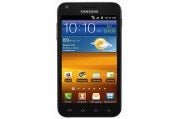 The arrival of Samsung's Galaxy S II
phones has been a long time coming. We first saw the next generation of
Samsung's popular line of Android phones back in February at Mobile
World Congress. After many successful months in Europe, the Galaxy S II
line of phones is finally coming to U.S. shores. The first of the
phones, the Samsung Epic Touch 4G ($200 with a two-year contract with Sprint; price as of September 12, 2011) will be available starting on September 16.
The arrival of Samsung's Galaxy S II
phones has been a long time coming. We first saw the next generation of
Samsung's popular line of Android phones back in February at Mobile
World Congress. After many successful months in Europe, the Galaxy S II
line of phones is finally coming to U.S. shores. The first of the
phones, the Samsung Epic Touch 4G ($200 with a two-year contract with Sprint; price as of September 12, 2011) will be available starting on September 16.Ridiculously Thin
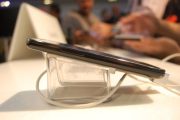 The
Epic Touch might be a bit larger than the previous generation of
phones, but it is incredibly thin. Measuring 5.1 inches by 2.7 inches by
0.38 inch, the Touch feels pretty comfortable in hand--and this is
coming from somebody with small hands! Samsung phones have a bit of a
reputation for being plasticky, and the Epic Touch unfortunately falls
under that descriptor. In her hands on
of the Epic Touch at Samsung's launch even, my colleague Melanie Pinola
remarked that it felt "less refined" than AT&T's Galaxy S II
version.
The
Epic Touch might be a bit larger than the previous generation of
phones, but it is incredibly thin. Measuring 5.1 inches by 2.7 inches by
0.38 inch, the Touch feels pretty comfortable in hand--and this is
coming from somebody with small hands! Samsung phones have a bit of a
reputation for being plasticky, and the Epic Touch unfortunately falls
under that descriptor. In her hands on
of the Epic Touch at Samsung's launch even, my colleague Melanie Pinola
remarked that it felt "less refined" than AT&T's Galaxy S II
version.On the bottom of the phone, you'll find the MHL port, a feature we've seen on many of this year's high-end smartphones. The MHL specification, which stands for Mobile High Definition Link, is a 1080p HD video and digital audio interface for connecting smartphones and other portable devices (tablets, cameras, and the like) to HDTVs. So what's the big deal? It simultaneously provides power to your phone--something that HDMI cables don't do.
Super AMOLED Plus Display
The 4.52-inch Super AMOLED Plus display on the Epic Touch is quite nice, but text isn't quite as sharp as what we saw on the European Galaxy S II. The Epic Touch's display is slightly larger than the European version (which has a 4.3-inch display) so it seems like the text sharpness may have been compromised by larger screen real estate. The text is still quite readable, but it is something I noticed right away upon using the phone.
Otherwise, the display's colors looked bright, details were crisp, and the viewing angles were very good. Blacks were deep, and colors were richly saturated without being overdone. Even when held in direct sunlight, the Epic Touch's display remained incredibly visible. Whites had a bit of a bluish tint, but it wasn't too noticeable. According to Samsung, Super AMOLED Plus displays have 50 percent more subpixels than the first-generation Super AMOLED displays (seen on the Vibrant, Mesmerize, and other Galaxy S phones) and perform even better than their predecessors in bright light.
Android Gingerbread With TouchWiz 4.0
The revamped TouchWiz 4.0 is fairly similar to the previous version, but it has a few aesthetic and functional enhancements here and there. For instance, the new lock screen displays missed calls and unread text messages; you can swipe these notifications rather than having to unlock your phone and then dig through menus to find the missed messages. The Epic Touch's keyboard isn't the native Android one, but it retains the multitouch key-chording feature (you can simultaneously press Shift and a letter to produce a symbol or number--no need to switch between modes) and the ability to use your voice to correct words as you type.
Taking a page from (or directly ripping off) HTC Sense, TouchWiz lets you pinch your homescreen to see thumbnail-size versions of all of your screens. Samsung borrowed another feature from HTC Sense, too: When the phone is ringing or playing music, you can silence it by flipping it face-down on a surface.
Contacts gets some cool new gesture-based functions. Swipe right on a friend's name, and you'll start a call with them; swipe left on their name, and you'll jump to the SMS composer, which you can use to send them a text message. Each of your contact's cards comes with your communication history--for example, when you last called, texted, or emailed the person.
One funny new feature is the ability to reject a call by sending a text message. Let's say that your brother is calling to ask when you're going to pay him back for dinner the other night. A menu will come up giving you the option to answer the call, hang up, or reject it with a text that says "I'll pay you back tomorrow!"
All of Samsung's Galaxy S II phones have six-axis motion sensing, powered by an accelerometer and a gyroscope. This feature is great for gaming, but Samsung also throws in some gesture-based phone controls. For example, you can zoom in and out of images in your gallery or in the browser by tilting the phone. This feature feels a bit awkward and unnecessary, however; I can't see myself ever using it.
TouchWiz isn't for everyone, so be sure to spend some time with it before purchasing a Galaxy S II phone.
Multimedia and Apps
Because this is a Sprint phone, you'll find all of the usual bloatware: Sprint Music Plus, Sprint Radio, Sprint TV and Movies, and Sprint NASCAR. You also get a game called N.O.V.A. HD and various apps--including Samsung's AllShare app for sharing media over DLNA servers.
Perhaps the coolest app Samsung provides on the phone (and on all Galaxy S II phones we've seen) is the company's own Kies Air. The app lets you view call logs, videos, photos, bookmarks, and IMs, and send SMS messages from PC. In order for the app to work, you'll have to install it on your PC and connect it to the same Wi-Fi network as your phone.
Like all Galaxy S phones, the Epic Touch provides the Media Hub for movie and TV-watching. Video looked fantastic on the handset's display and played back smoothly. Even if you don't like Samsung's Media Hub, you'll want to watch a lot of movies and TV shows on this phone. Unlike the European version, the Epic Touch 4G does not have the Readers or Music Hub for purchasing ebooks or MP3s, respectively.
Performance
Like the AT&T Galaxy S phone, the Epic Touch is powered by a 1.20GHz dual-core Samsung Exynos processor. The Epic Touch booted up in 20 seconds, which is pretty fast; in contrast, the Droid Bionic took 43 seconds to turn on fully.
We also tested the phone using Qualcomm's new benchmarking app, Vellamo, to see how a Samsung processor would fare against its competitors. The Epic Touch 4G earned a very impressive score of 914, putting it right behind the Galaxy Tab 10.1 for overall performance and ahead of two phones running Qualcomm chips--the HTC Sensation 4G and the HTC EVO 3D. You should take these results with a grain of salt, since Qualcomm manufactures the app, but the data is interesting to compare.
I experienced reliably good Sprint WiMax 4G coverage in San Francisco. I had a strong 4G signal pretty much everywhere I went in the city. Sprint's 4G network paired with the Samsung Exynos dual-core processor makes for some excellent Web browsing, too. Over 4G, PCWorld.com (the full site) loaded in a speedy 12.1 seconds. Image-heavy site TheBoldItalic.com loaded in 10.1 seconds, and media-heavy ThrasherMagazine.com loaded in 13.6 seconds.
Of course, 4G coverage and signal strength vary depending on where you live in the country and whether your city even offers 4G. We have good 4G coverage in San Francisco; but in our 4G Phone Shootout, Sprint had the poorest country-wide coverage.
Call quality over Sprint was very good overall. My friends and family said that they could hear my voice perfectly and described it as sounding natural.
Superb 8-Megapixel Camera
 When
we reviewed the European version of the Galaxy S II, we were impressed
by its 8-megapixel camera. Luckily, Samsung seems not to have changed
the sensor for the U.S. versions. The Epic Touch took excellent photos
indoors and out. My only complaint is that colors in my indoor photos
looked a bit oversaturated. Details were quite sharp and I didn't detect
any graininess or pixelation. The shutter speed on the camera was fast
enough to capture photos of sports, kids, and other quick-moving
subjects. Again, I must lament the lack of a physical shutter
When
we reviewed the European version of the Galaxy S II, we were impressed
by its 8-megapixel camera. Luckily, Samsung seems not to have changed
the sensor for the U.S. versions. The Epic Touch took excellent photos
indoors and out. My only complaint is that colors in my indoor photos
looked a bit oversaturated. Details were quite sharp and I didn't detect
any graininess or pixelation. The shutter speed on the camera was fast
enough to capture photos of sports, kids, and other quick-moving
subjects. Again, I must lament the lack of a physical shutter  button, but the camera's quality makes up for it.
button, but the camera's quality makes up for it.Like the HTC Sensation 4G, and the Epic Touch 4G supports up to 1080p HD video capture. Video quality was good: The Epic Touch could handle fast-moving cars and slower-moving people without distortion or pixelation.
Bottom Line
We'll be conducting formal lab testing over the next few days, but right now, it looks as though the Epic Touch 4G is the fastest Android smartphone out there. On top of its speediness, it has a superslim design, a gorgeous display, and a superb camera. My only complaint is the amount of carrier and manufacturer-added bloatware on the phone, but that's pretty much par for the course these days.
Samsung Galaxy Nexus


Pros
- 4G/LTE is very fast
- Ice Cream Sandwich is a real treat
- Slim, curved design
Cons
- No expandable memory
- No Google Wallet support
- Camera is just okay
Bottom Line
The best
Android phone to date, the Galaxy Nexus dazzles with its curved display,
sleek design, fast performance, and, of course, the Ice Cream Sandwich
update.
Samsung Galaxy Nexus Review: Sleek and Speedy
We’ve been clamoring to get our hands on the gllaxy nexus ever since its unveiling in Hong Kong back in October. Finally, at long last, the U.S. version of the Galaxy Nexus has landed in our office. So is the Galaxy Nexus, the first phone to run Android Ice Cream Sandwich, everything we hoped it would be? Mostly, yes. The Galaxy Nexus ($300 with a two-year contract, as of December 16, 2011) impresses with lightning-fast performance, strong data speeds, a thin design, and, of course, all of that goodness. It isn’t perfect, however. The camera isn’t outstanding, and the handset has no expandable memory slot. But as it stands, the Galaxy Nexus is the best Android phone currently available.Design
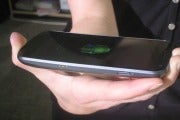 The
Galaxy Nexus is one fine-lookin’ piece of hardware. The glossy display,
piano-black bezel, and textured back are all standard Samsung design
elements. But unlike other Samsung Galaxy phones I’ve reviewed, the
Galaxy Nexus feels high quality. At 5.1 ounces, it has a nice
substantial weight to it without being too heavy. As you can see from
the photos, the Galaxy Nexus has a subtle curve, which nicely contours
to the hand. If you have small hands like me, however, you might find
the Galaxy Nexus a bit large (it measures 5.33 by 2.67 by 0.37 inches).
The
Galaxy Nexus is one fine-lookin’ piece of hardware. The glossy display,
piano-black bezel, and textured back are all standard Samsung design
elements. But unlike other Samsung Galaxy phones I’ve reviewed, the
Galaxy Nexus feels high quality. At 5.1 ounces, it has a nice
substantial weight to it without being too heavy. As you can see from
the photos, the Galaxy Nexus has a subtle curve, which nicely contours
to the hand. If you have small hands like me, however, you might find
the Galaxy Nexus a bit large (it measures 5.33 by 2.67 by 0.37 inches).The Galaxy Nexus has no physical hardware keys on its face. Instead, the touch-sensitive Back, Home, and Search keys are built into the display as soft keys.
Super AMOLED Display (No Plus)
The Galaxy Nexus has a high-def Super AMOLED display--not to be confused with the Super AMOLED Plus technology found in the Samsung Galaxy S II line of phones. This 1280-by-720-pixel display is actually based on a PenTile pixel structure in which pixels share subpixels. points out that the Galaxy S II phones have full RGB displays in which the pixels have their own subpixels. This means that the Galaxy Nexus has lower overall subpixel density, reduced sharpness, and degraded color accuracy than the Galaxy S II. But according to site flat panel hd the Galaxy Nexus has 315 pixels per inch, which is slightly lower than the iPhone 4/4S at 326 ppi.To be quite honest, the only quality difference I saw between the Galaxy S II, the Galaxy Nexus, and the iPhone 4S was in color accuracy. Colors on the Galaxy Nexus had a slight yellowish tint, mainly in pictures or websites with a white background. Otherwise, blacks looked deep, while fonts and details appeared sharp. Unless you’re crazy about pixel density or have insanely sharp eyes, you probably won’t notice the slight display downgrade.
The display is a roomy 4.65 inches, but really only 4 inches of that real estate is usable. The remaining 0.65-inch space is occupied by a customizable shortcut bar that appears at the bottom of the home screens as well as some other internal screens. Even so, the screen feels plenty spacious for all of your gaming, video, and other multimedia desires.
Ice Cream Sandwich: Simply Sweet
We’ve written extensively on Ice Cream Sandwich, and will be doing much more in-depth coverage in the next few days. For this review, I’ll focus on how Ice Cream Sandwich performs on the Galaxy Nexus.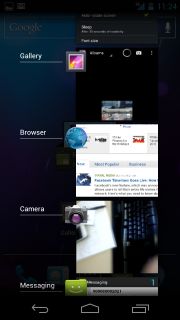 The Recent Apps screen. If
you’re familiar with Android Honeycomb on tablets, you’ll find a few
familiar features in Ice Cream Sandwich. As in Honeycomb, widgets in Ice
Cream Sandwich are now resizable on the home screen. You'll also find a
dedicated on-screen Recent Apps button for seeing all of your open
apps; just as on Android tablets, it displays a scrollable list of
running apps with thumbnail images. Flicking through and switching
between apps is not as speedy as I would like it to be, however--I
encountered a noticeable delay when going from one app to another.
The Recent Apps screen. If
you’re familiar with Android Honeycomb on tablets, you’ll find a few
familiar features in Ice Cream Sandwich. As in Honeycomb, widgets in Ice
Cream Sandwich are now resizable on the home screen. You'll also find a
dedicated on-screen Recent Apps button for seeing all of your open
apps; just as on Android tablets, it displays a scrollable list of
running apps with thumbnail images. Flicking through and switching
between apps is not as speedy as I would like it to be, however--I
encountered a noticeable delay when going from one app to another.You’ve probably heard a lot of buzz about the ability to unlock your phone with your face. The front-facing camera snaps a picture of you and then uses facial recognition software the next time you unlock your phone. It's cool, most definitely, but it's not the most secure way of protecting your phone. As Google warns, somebody who looks similar to you can unlock your phone with their face. Nevertheless, face unlock works well, and it is a pretty neat--although somewhat gimmicky--feature.
The Android software keyboard in Ice Cream Sandwich has larger, more square keys so it is easier to type on (though I still made a few errors here and there). You now have an option to verbally dictate your text, as well, though I didn’t always find it accurate. For example, “This is a test of the auto-dictate feature” translated into “Types of the otter dictate feature.”
Developers will delight in the dedicated “Developer options,” which let you access tools such as a CPU usage meter and controls for touchscreen feedback and the background process limit. It is features like this that truly make Android a standout operating system. There’s something for everyone.
The Core Apps
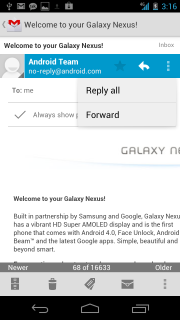 The new Gmail with the Action Bar. Gmail
gets a face-lift, with a new context-sensitive Action Bar at the bottom
of the screen. The bar changes depending on where in the app you are.
For example, when you’re looking at an email message, you see options to
archive it, trash it, label it, or mark it as unread. When you’re
viewing your inbox, the bar changes to display options for composing new
messages. Adding attachments from your gallery or other folders is now
much easier as well. If you’re a heavy Gmail user like me, you’ll really
appreciate these updates.
The new Gmail with the Action Bar. Gmail
gets a face-lift, with a new context-sensitive Action Bar at the bottom
of the screen. The bar changes depending on where in the app you are.
For example, when you’re looking at an email message, you see options to
archive it, trash it, label it, or mark it as unread. When you’re
viewing your inbox, the bar changes to display options for composing new
messages. Adding attachments from your gallery or other folders is now
much easier as well. If you’re a heavy Gmail user like me, you’ll really
appreciate these updates.The browser in Ice Cream Sandwich is just about as close as you can get to a desktop one. You can now set the browser to request full desktop versions of sites, not the lesser mobile versions. You can also sync your bookmarks from the desktop Chrome browser to the Browser app in Ice Cream Sandwich. Google has added support for tabbed browsing, and you can quickly view which tabs are open, each with a live preview of that page.
Google Calendar pretty much runs my life, so I was pleased to see a cleaner, easier-to-read version of it in Ice Cream Sandwich. I also appreciate the fact that you can pinch-to-zoom in on a particular calendar event to see more information about it; previously you had to tap on the calendar event, and it would open a new window. Like all of the other core-apps updates, Google has made everything in the Calendar more efficient and easier to use.
Unfortunately, Google Wallet is not supported on the Galaxy Nexus--despite the fact that the phone’s hardware supports NFC.
Performance
The Galaxy Nexus is powered by a dual-core 1.2GHz Texas Instruments OMAP 4460 processor, with 1GB of RAM and 16GB or 32GB of storage. The Galaxy Nexus scored well on all of our benchmark tests (which includes the Sunspider JavaScript benchmark and the GLBenchmark). Interestingly, the Nexus’s overall score was about the same as the mark of the Motorola Droid Razr, which has a 1.2GHz TI OMAP 4430 processor. The Samsung Galaxy S II for T-Mobile scored slightly higher overall than the Galaxy Nexus.We also ran the Qualcomm-developed Vellamo benchmarking app, on which the Galaxy Nexus earned a score of 803. (The droid razar got a score of 1040, which put it ahead of the Samsung Galaxy S II.) This score puts the Galaxy Nexus ahead of the Samsung Skyrocket and the HTC EVO 3D. Because Vellamo was made by a competitor to Texas Instruments, we tend to take these results with a grain of salt.
We’re lucky enough to get very strong 4G LTE coverage here in San Francisco. In my tests using the FCC-approved Ookla Speedtest app, the Galaxy Nexus achieved download speeds ranging from 6.69 to 12.11 megabits per second and upload speeds of 21.18 mbps. In other words, the Galaxy Nexus is blazingly fast.
Call quality over Verizon’s network in San Francisco was consistently good. I had great coverage everywhere I went in the city. My friends and family sounded natural, with an ample amount of volume. One of my friends remarked that my voice sounded “hollow,” but other people I spoke with were pleased with the quality.
We have not yet finished our formal battery life tests, but the Galaxy Nexus survived through a whole day of heavy use before I needed to charge it again.
Camera
 At
the Hong Kong unveiling, Google bragged that the camera on the Galaxy
Nexus has zero shutter lag. In my hands-on tests, I found these claims
to be accurate: It processes your photo almost instantly after you press
the shutter key. Another nice feature is the ability to access the
camera from the lock screen rather than having to unlock and then dig
through menus.
At
the Hong Kong unveiling, Google bragged that the camera on the Galaxy
Nexus has zero shutter lag. In my hands-on tests, I found these claims
to be accurate: It processes your photo almost instantly after you press
the shutter key. Another nice feature is the ability to access the
camera from the lock screen rather than having to unlock and then dig
through menus.Unfortunately, the camera just isn’t of the same caliber as the rest of the phone. The photos I shot with the Galaxy Nexus’s 5-megapixel camera
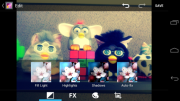 You can apply a variety of filters to your photos.
You can apply a variety of filters to your photos. looked a bit flat. Colors seemed a touch washed out, and details were a little fuzzy.
looked a bit flat. Colors seemed a touch washed out, and details were a little fuzzy.But even if your photos don’t come out perfect, Ice Cream Sandwich has your back with its suite of photo-editing tools. You get an array of filters (like your very own Hipstamatic app), the capability to adjust the image angle, red-eye removal, cropping functions, and more. Any edits you make to a photo will create a copy, in case you ever want to revert to the original.
In camcorder mode, you can record video in up to 1080p. Video in my tests looked quite good. The camera handles motion well, with no artifacting or pixelation. Check out the test clip below.
Bottom Line
The Samsung Galaxy Nexus is a superb phone, and a great vehicle for introducing Android Ice Cream Sandwich to the world. Android has clearly come a long way, and the tweaks and updates Google has implemented throughout the operating system make a huge difference in efficiency and ease of use. Right now, the Galaxy Nexus is the best Android phone you can buy.
Subscribe to:
Posts (Atom)







